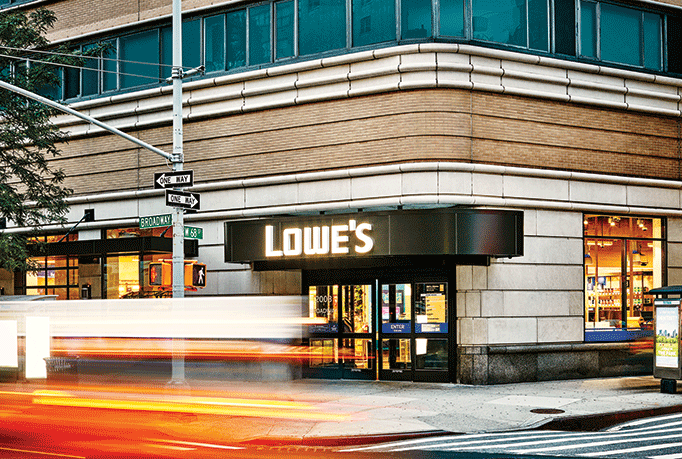
Lowe’s seems to be betting that a scaled-down version of the traditionally massive home-improvement format it recently introduced in New York City will meet the special needs of the urban dweller. The first of these stores opened in September, on Broadway at West 68th Street, in the borough of Manhattan. This was followed by a second, downtown, on Sixth -Avenue at West 19th Street, in the Chelsea neighborhood.
The new urban prototype offers 22,000 square feet of ground-floor selling space, which is less than a fifth the size of the typical multilevel Lowe’s store. The company concluded that the time was right, having discovered that Manhattan residents were already shopping its e-commerce site and also its stores in some of the other New York City boroughs. “We have identified an opportunity to better serve customers, both DIY and Pro, in dense urban markets,” said Lowe’s spokeswoman Karen Cobb, referring to the chain’s do-it-yourself and professional customers, respectively. The new store will give Manhattan residents greater access to all of Lowe’s offerings, she says, whether right off the store shelves or by pickup or delivery of online orders.
The store incorporates Lowe’s -findings about the neighborhood’s online shopping patterns. The merchandise assortment is curated especially for the apartment dweller — meaning more storage and organization products, remodel-oriented wares, and appliances built for smaller kitchens, while shovels, rakes and the like were understandably edited out of the mix, according to Joseph Jacobson, a partner at New York City–based Madison Capital, which owns the space.
The prototype is quite a departure from the cavernous multilevel store environment common to home-improvement chains, Jacobson says. “They were looking to build a consumer-friendly store in much fewer square feet than competitors have done,” he said. The street-level store is housed inside a luminous building with wide aisles and 20-foot-high ceilings. The stores offer such services as on-site interior designers who make house calls, and curbside merchandise pickup.
The area is affluent, and its residents are willing to spend time and money on their homes, says Jacobson. Nearly 170,000 reside within a mile of the store, and the monthly retail spending amount among those who live within two miles exceeds $4,000, he says. The average age of these residents is 41, and the estimated income of the mainly two-person households is $160,000 per year.
Asked how the store differs from rival Home Depot’s Manhattan unit, Cobb replies that the retailer developed its strategy based on insights about key markets where Lowe’s is underrepresented. “The first option we evaluated was serving dense cities solely through our omni-channel capabilities,” she said. “We are already seeing early success with growing Lowes.com and in-home sales in these markets, but as we looked at the relative level of market share these options provided, we determined we could do more. These insights provided a fresh perspective on the Manhattan market, which led us to a smaller store footprint.”
Cobb declined to offer specifics about future urban-market regions, but the company plans to open some 30 stores next year and the following, split evenly between its namesake units and its Orchard Supply Hardware chain. “We’re evolving our store concepts to capitalize on opportunities in metro and urban markets — digging deep into unique local characteristics on a market-by-market basis,” Cobb said. “We believe this tailored format store … will provide the insights we need to better understand and serve urban consumers.”